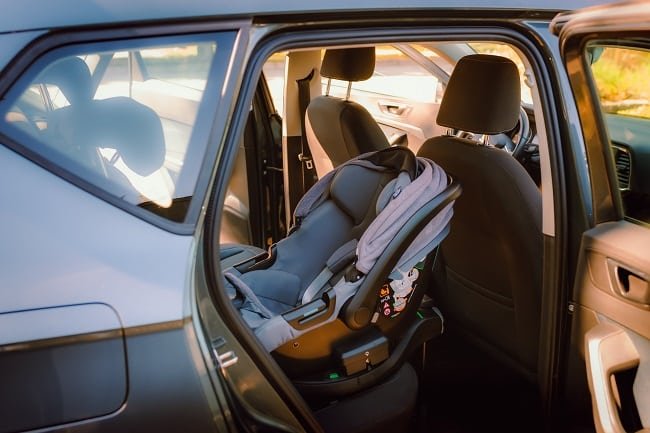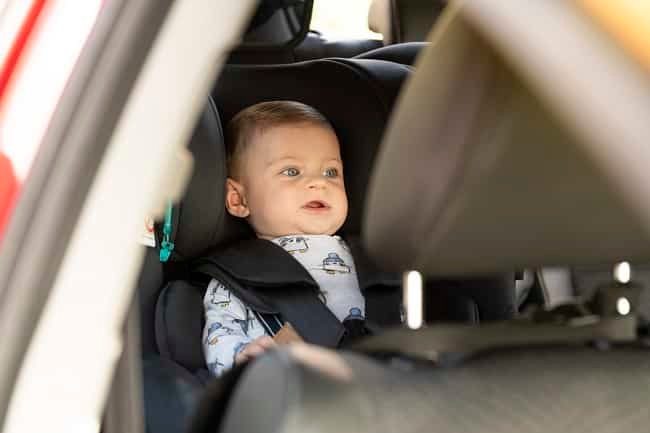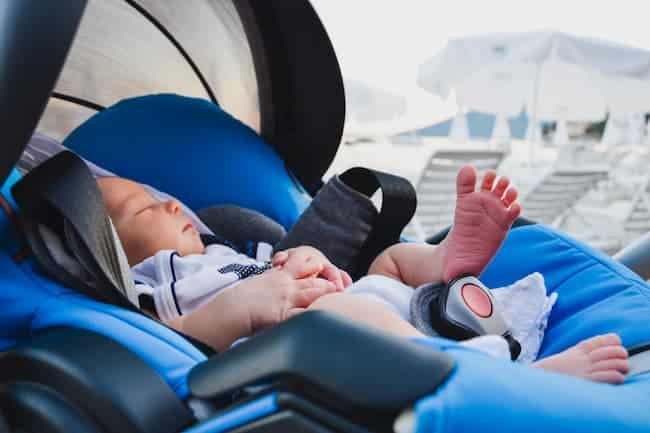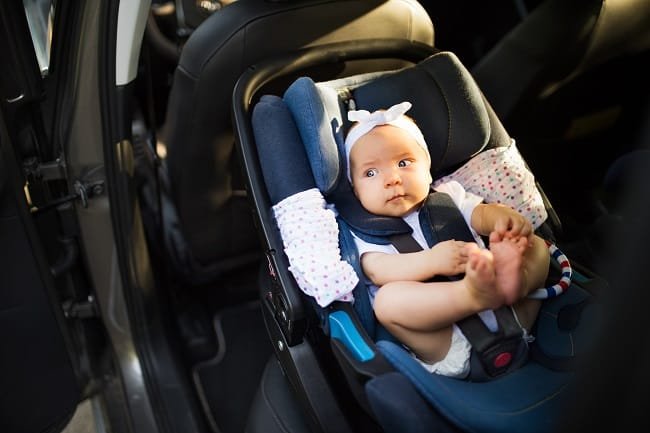When we are about to set up our new TV, we analyze the situation on whether we should put the TV on the table or mount it up on the wall to see which position is better and safer. Similar to that situation, many parents are confused and worried about whether a newborn car seat should be placed behind the driver’s seat or the passenger’s seat. Worry no more, as today we will be discussing which side is safer and better for a newborn child to sit on his/her car safety seat. Follow us and be enlightened.
Car safety seats are crucial if you have a newborn child or a toddler but more importantly, if you have a newborn child, then you must buy a car safety seat. A car safety seat isn’t just a fancy separate seat to place your newborn child but it’s mainly to protect your newborn child from all kinds of harm, especially during an accident as a car safety seat’s job is to protect your child at all times.
Without a car safety seat, you will be putting your newborn child’s physical health at a great risk since accidents can happen anytime and it’s better to be prepared during such tragedies. While a car safety seat might be a bit expensive but it isn’t something that you are buying on a daily basis so spending that much for one time won’t be a lot. Let us move forward and take a look at the factors that we should consider while placing a car safety seat.
Where should a newborn car seat be placed in the car?
If at all feasible, a newborn car seat should be placed in the middle of the rear seat. The middle position of the car seat offers the most separation from the sides of the car, lowering the risk of harm in the case of a side-impact incident. In the event of a frontal accident, it also provides improved protection against possible incursions.

If the car seat cannot be installed in the middle position, the next safest option is typically the rear passenger side of the vehicle. This is because it allows the driver to keep an eye on the baby through the rearview mirror and is generally considered safer than the rear driver’s side due to potential collision risks from the driver’s side.
As we mentioned earlier in our article on Car seat safety for newborns: What You Need to Know to Keep Your Baby Safe using LATCH(Lower Anchors and Tethers for Children) step by step. You can follow the instructions correctly there. Additionally, always follow the specific guidelines provided by the car seat manufacturer for the age, weight, and height of the child, as well as any other specific instructions for safe installation and usage.
Factors to consider when deciding newborn car seat behind the driver or passenger:
Before we randomly place the car safety seat on our car seats, we need to inspect and take a look at all the factors that we need to consider before placing the car safety seat. If we don’t take a look at all the factors then we will be making a huge mistake as there might be a flaw in the plan and since we ignored it, it will cost us later on during an accident. Therefore, let us take a look at the list below
The size and the layout of the car:
The size, layout, and overall design of the car are very important, as the size of the car seats in a Toyota Corolla won’t be the same as a GMC Yukon since GMC Yukon’s seats are much wider, bigger, and, more spacious when compared to a Toyota Corolla. You can probably fit around 5 car safety seats onto the car’s seat whereas you can maybe fit around just 3 car safety seats inside a Toyota Corolla.
You need to fit see how big is your car’s backseat and how spacious it is and then look for the car safety seats that will fit into that much space. You should get a precise-sized car seat as a too-big car safety seat will be unbalanced and might keep on rocking the baby back and forth if not adjusted properly and a too-small car safety seat could possibly be small to fit your newborn child after a few months which will lead to you buying another car safety seat.
The number of children riding the car:
Another factor that you also need to consider is the number of children riding in the car. Not only do newborn children need to be equipped with a car safety seat but also toddlers since they tend to move too much from here to there and that can be dangerous inside a car so the best option would be to strap them onto a car safety seat as that would provide them the safety they require whilst reducing their movements inside the car.
In some countries, there are laws that require children to use a car safety seat until the age of 8 and in some countries, the age limit is till 10 years old. During such cases, you need to count how many of your children need a car safety seat and then set them up accordingly. Since car safety seats are known to take up a bit too much space on the sides, you need to take a look at the measurements and decide which ones to get if you plan on getting several for your newborn children and toddlers.
The need for easy access to the car seat for the parent/caregiver:
When placing your newborn child’s car safety seat in the backseat, you need to make sure that you have easy physical access and visual access to your newborn so that, in case of an emergency, you can tend to your newborn baby if it needs to be. If you don’t have easy visual access or physical access to your newborn child, then it will be a stressful and anxious situation for both the parent and the newborn child as neither won’t have direct contact with one another and that could lead the baby to crying a lot.
Placing the newborn child’s car safety seat behind the driver seat will provide easy physical and visual access to the newborn children since it will be hard for the parent to reach the newborn child. If the car safety seat is placed behind the passenger seat and the driver won’t be able to focus on the road and take care of the baby at the same time.
The need to minimize the risk of injury in the event of a collision:
In the event of a collision, the driver will always make sure to protect the passenger’s side at all times since he/she has control of the vehicle at the time being. If the newborn child’s car safety seat is placed behind the passenger’s seat, it will be much safer during the event of a collision.
Benefits and Drawbacks of Placing the newborn car safety seat behind the driver’s Seat:
Now that we have taken a look at the factors that need to be considered before adjusting and placing a car safety seat for your newborn child, let us take a look at the benefits and drawbacks of placing your child behind the driver’s seat.
Advantages:
- When a car safety seat is placed behind the driver’s seat, the passenger will have easy both physical and visual contact with the newborn child. Since he/she has proper access, then they will be able to tend towards the newborn child if need be.
- When parking in spaces that require the driver to exit from the driver’s side, having the newborn car safety seat positioned behind the driver’s seat allows for easier loading and unloading of the baby, as the parent or caregiver can simply open the door and access the car seat.
Disadvantages:
- In the event of a collision, both the newborn child and the car safety seat will be at high risk as it is very dangerous and could be fatal during a side-impact collision, which could injure the newborn child pretty badly.
- If the driver is the only person in the car except for the newborn child, then it will be hard for him/her to reach the newborn child to care for it and tend to the newborn child’s needs.
- When you are placing the newborn car safety seat behind the driver’s car seat can reduce the visibility of the baby for the driver while using the rearview mirrors. It’s really challenging for the driver to keep an eye on the newborn while driving.
- In certain situations, the driver may find it more difficult to reach the baby when the car seat is positioned behind his or her seat.
Benefits and Drawbacks of placing the car safety seat behind the passenger’s seat
Now that we have taken a look at the factors that need to be considered before adjusting and placing a car safety seat for your newborn child and also the benefits and drawbacks of placing your newborn child’s car safety seat behind the driver’s seat, let us take a look at the benefits and drawbacks of placing your child behind the passenger’s seat.
Advantages:
- During the event of a collision, it is much safer for both the newborn child and the car safety seat to be seated behind the passenger seat as there is much less impact when compared to sitting behind the driver’s seat.
- Even though it isn’t safe while the car is moving but when the car is at a halt, then the driver can easily take care of the newborn child while the newborn child is placed in his/her car safety seat in the back seat. Better communication between the infant and the front-seat passenger is made possible when the vehicle safety seat is installed behind the passenger’s seat.
- Placing the car safety seat behind the passenger seat allows for convenient access to the baby during stops or breaks. The front-seat passenger can easily attend to the baby’s needs without requiring the driver to leave the vehicle or navigate around the car.
Disadvantages:
- Sometimes the passenger might accidentally tilt his/her seat all the way back and since the car safety seat is placed behind the passenger seat, it might hit the baby in his/her face, injuring her and making her cry for a long time.
- Since both the car safety seat and the newborn child are placed behind the passenger’s seat, this will limit both the visual and physical access to the child, which might end up stressing both the parents and the newborn child and make them anxious.
- With the car safety seat positioned behind the passenger’s seat, the driver’s visibility of the baby might be restricted. This can make it more challenging for the driver to monitor the baby’s well-being while driving, particularly when using rearview mirrors or other visual aids.
Why is the newborn car seat behind the driver the safest?
Actually, there is no consensus or conclusive evidence to support the notion that the seat behind the driver is the safest. The safety of various seating positions in a car can vary depending on a number of variables, including the situation at hand and the kind of collision being thought about. The idea that the seat behind the driver is the safest is not consistently substantiated, despite several research suggesting that the back seat is typically safer than the front seat.

Here are a few reasons that we find why the back seat is often considered safer than the front seat:
Distance from frontal impacts:
In head-on collisions, the front seat occupants are typically more vulnerable to injuries due to the proximity to the point of impact. As the back seat always remains far away from the front of the car so it may provide some extra protection as well as less damage in such situations.
Reduced risk from airbags:
Frontal airbags are made to inflate violently in order to protect passengers during a collision. Although they frequently successfully prevent injuries, they can present a larger danger to passengers who are seated very close to them. The danger of harm from the deployment of the airbags may be reduced because the back seat is often further away from them.
Side impact protection:
In case of any side collision, the back seat may offer better protection than the front seat. This is because the side structure of vehicles is typically reinforced to better protect rear-seat occupants, reducing the risk of injury from the side impact forces.
Should infant car seats be at or below shoulders?
The harness straps should be placed at or below the baby’s shoulders when installing an infant or newborn car seat. This will provide adequate safety and restraint in the case of a collision. Here are a few reasons why the straps should be at or below the shoulders:
Secure upper body:
Placing the harness straps at or below the shoulders helps to secure the baby’s upper body in the car seat. This ensures that the harness is properly positioned to hold the baby’s torso and upper body in place, minimizing the risk of excessive movement or ejection in the event of a collision.
Prevent submarining:
Submarining refers to the dangerous phenomenon where a child’s body can slide forward under the harness during a crash, potentially leading to severe injuries. By positioning the harness straps at or below the shoulders, the risk of submarining is reduced, as the straps can better hold the child securely in the seat.
Proper alignment with the car seat shell:
The car seat’s design and structure are engineered to provide optimal protection when used correctly. Placing the harness straps at or below the shoulders ensures that the baby’s body aligns properly with the car seat shell, maximizing the effectiveness of the seat’s safety features.
It’s essential to carefully follow the manufacturer’s instructions for installing and using the specific infant car seat you have, as different car seat models may have slight variations in their guidelines. Always refer to the car seat manual for the correct positioning of the harness straps and any other specific instructions regarding the proper use of the car seat.
How Much Weight Can an Infant Car Seat Hold?
As parents and caregivers, it is important to know how much weight an infant car seat can hold to ensure the proper protection of our precious passengers. In this section, we will explore the weight limits of infant car seats and provide essential information for responsible use.
Weight Limits and Guidelines:
Infant car seats are specifically designed to accommodate newborns and infants up until they reach a certain weight or height limit. The weight limit varies from one car seat model to another, so it is essential to refer to the manufacturer’s guidelines for accurate information. However, as a general rule, most infant car seats have a weight limit ranging from 22 to 35 pounds (10 to 16 kilograms).
Factors Affecting Weight Limits:
Several factors can influence the weight limits of infant car seats. Manufacturers consider various safety aspects and engineering constraints when determining these limits. Here are a few key factors to keep in mind:
Safety Standards:
Car seat manufacturers adhere to strict safety standards set by regulatory bodies. These standards ensure that car seats are designed and tested to provide adequate protection for infants within the specified weight range.
Structural Integrity:
Infant car seats are engineered to withstand certain weight limits without compromising their structural integrity. Exceeding the weight limit may strain the seat’s components, potentially reducing its ability to protect the child in the event of an accident.
Compatibility with Base:
Infant car seats are often used in combination with a base that is installed in the vehicle. The weight limit also considers the base’s capability to provide stability and support to the car seat system.
Ease of Carrying:
Infant car seats are designed to be portable, allowing parents to move the seat with the baby in and out of the vehicle easily. The weight limit takes into account the practicality of carrying the car seat while ensuring the caregiver’s comfort and safety.
Recommendations for Safe Use:
To ensure the safety of your child, it is important to follow these recommendations regarding infant car seat use:
Read the Manual:
Always refer to the manufacturer’s instructions and guidelines for your specific car seat model. These instructions provide accurate information regarding weight limits, installation, and usage.
Proper Installation:
Make sure the car seat is installed correctly in your vehicle. Follow the instructions provided by the manufacturer and seek professional help if needed. A well-installed car seat maximizes safety.
Transitioning to the Next Stage:
As your child grows and reaches the weight or height limit of the infant car seat, it is important to transition to a suitable forward-facing car seat to continue providing proper protection.
If I’m the only person in the car and since I’m driving, I won’t be able to take care of baby in the backseat. So, what is the best solution in that case?
Even though it isn’t safe to place the baby on the front passenger but since there are no other options to take care of the baby while you are driving the car, you can place your baby in the front passenger seat. However, you need to make sure that his/her car safety seat has been placed in the correct position and adjusted perfectly and make sure to deactivate the airbag. Deactivating the airbag is very crucial so that during the event of a collision, the sensors don’t go off and hit the baby in the face with the airbag, further injuring the newborn child.
Conclusion:
Now that we have reached the end, we have discussed whether one should position and adjust the car safety seat for the newborn child behind the driver’s seat or the passenger’s seat. By reading this article, you can make up your mind on which side is better for you. It is safer to place the car safety seat behind the passenger’s seat to protect the newborn child during any collision event but placing your car safety seat behind the driver’s seat will provide easy visual and physical access to the newborn child.
We all want to protect our newborn children from harm but also need to be there for them. You can also try to consult with a Child Passenger Safety Technician and let them personally guide you on which option would be better placing your car safety seat behind the driver’s seat or the passenger’s seat. We all face different kinds of problems every day and we at Hacks for Cars try our best to help everyone with their problems and make sure that they leave our site with a smile on their face. I hope that this piece of the article was able to educate you on whether you should place your car safety seat behind the driver’s seat or the passenger’s seat. If you have any other questions about other problems, then you can refer to our other articles, which might help you.


